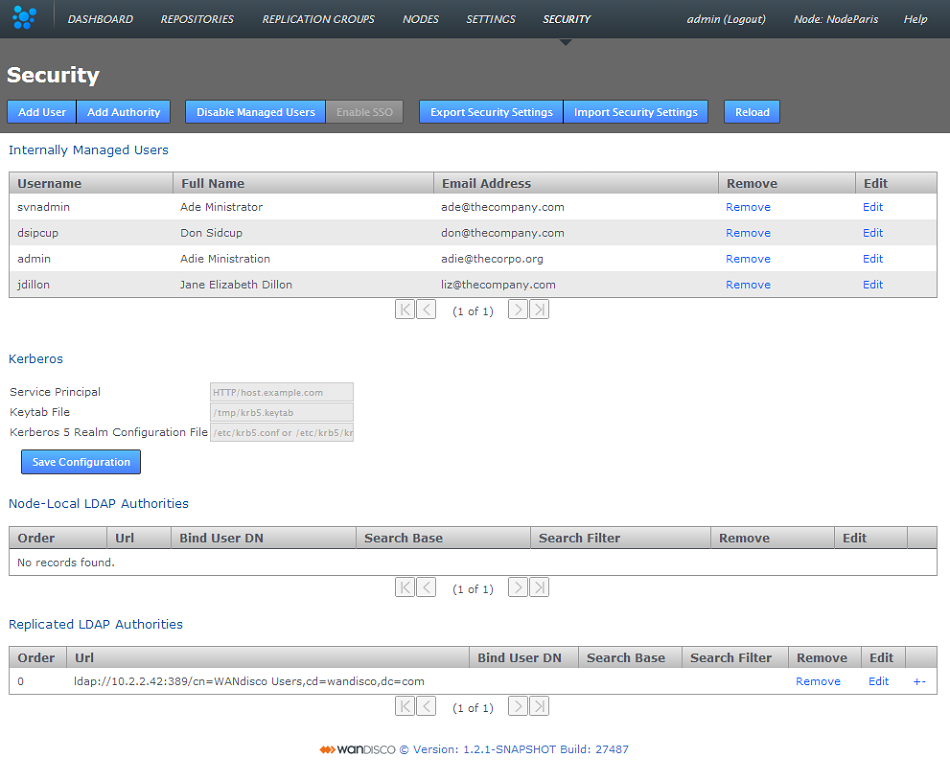

The security tab is used to manage admin accounts, either entered manually into SVN MultiSite Plus or managed through an LDAP authority. On the tab is an entry form for multiple admin accounts, along with LDAP Settings for binding MultiSite to one or more LDAP services.

SVN MultiSite Plus - Security
SVN MultiSite Plus uses the following order of precedence when checking for authentication of users:
This provider implementation tries to authenticate user credentials against either the list of internally managed users, or against any number of LDAP authorities, or both -- depending on how the administrator has configured the application.
When authenticating against LDAP authorities, each one is tried in sequence until one either grants access or they all deny access. In the event that they all deny access, only the error from the last authority tried will be returned.
 Admin Accounts
Admin AccountsClick the Disabled Managed Users button if you want to control access to SVN MultiSite Plus exclusively through LDAP. Once clicked, any Internally managed users will no longer be able to log into the Admin UI after they next log out. From that point only LDAP managed users will have access to the SVN MultiSite Plus Admin UI.
 Re-enable Internally Managed users
Re-enable Internally Managed users/opt/wandisco/svn-multisite-plus/replicatorand run the reset script:
java -jar resetsecurity.jarAny internally managed users who remain in SVN MultiSite's database will have their access restored.

SVN MultiSite Plus - Internally Managed Users
This table lists those admin users who have been entered through the Admin UI or imported using the Import Security Settings, along with the first admin account.
Note that the first admin account is the one set up during the installation of your first node. The credentials specified during this installation are stored to the users.properties file which is then used during the installation of all subsequent nodes.
 Admin Account Mismatch
Admin Account Mismatch
The users.properties file is used to ensure that exactly the same username/password is used on all nodes during installation. In the even that there's a mismatch then you wouldn't be able to connect the nodes together (through the Induction process). Rather than clean-up and reinstall you can fix this by manually syncing the password files.
Admin Account #1 can be removed but the last admin account remaining on the system will not be deletable to ensure that it isn't possible for an administrator to be completely locked out of the admin UI.
Support for the Kerberos protocol is now included. When enabled, Kerberos handles authentication for access to the admin UI, where the administrator is automatically logged in if their browser can retrieve a valid Kerberos ticket from the operating system.
 You can't mix and match log-in type
You can't mix and match log-in type
When Kerberos SSO is enabled only users who are set up for Kerberos will be able to access the admin UI. The username and password login form will be disabled. If you ever need to disable Kerberos authentication this can be done using the authentication reset script which will return your deployment to the default login type.

kerberos settings entry form
HTTP/host.example.com
/tmp/krb5.keytab
/etc/krb5/krb5.conf
 Never replicated, always configured 'per-node'
Never replicated, always configured 'per-node'/etc/krb5.keytabThe location of the host's Kerberos 5 realm configuration may be something like /etc/krb5.conf or /etc/krb5/krb5.conf

LDAP Authority entry forms
Both kinds of authority are supported simultaneously, with the node-specific LDAP authorities taking precedence over WAN-based authorities in order to support the use-case where, for example, a particular node may prefer to use a geographically closer LDAP directory. Also, if multiple LDAP authorities of either type are configured then the order in which they are consulted is also configurable, using the +/- buttons at the end of each entry.
The usual configuration options are supported for each configured LDAP authority: URL, search base and filter and bind user credentials. Note that the bind user's password cannot be one-way encrypted using a hash function because it must be sent to the LDAP server in plain text, so for this reason the bind user should be a low privilege user with just enough permissions to search the directory for the user being authenticated. Anonymous binding is permitted for those LDAP servers that support anonymous binding.
When adding an LDAP authority, the configuration can be selected to be either replicated or node-specific.
If node-specific is chosen, then only the local node will use the LDAP authority for authentication. Both kinds of authority are supported simultaneously, with the node-specific LDAP authorities taking precedence over WAN-based authorities in order to support the use-case where a particular node may prefer to use a geographically closer LDAP directory, for example. Also, if multiple LDAP authorities of either type are configured then the order in which they are consulted is also configurable.
The usual configuration options are supported for each configured LDAP authority: URL, search base and filter and bind user credentials.
 Just enough permissions
Just enough permissions
The bind user's password cannot be one-way encrypted using a hash function because it must be sent to the LDAP server in plain text. For this reason the bind user should be only have enough privileges to search the directory for the user being authenticated. Anonymous binding is permitted for those LDAP servers that support anonymous binding.